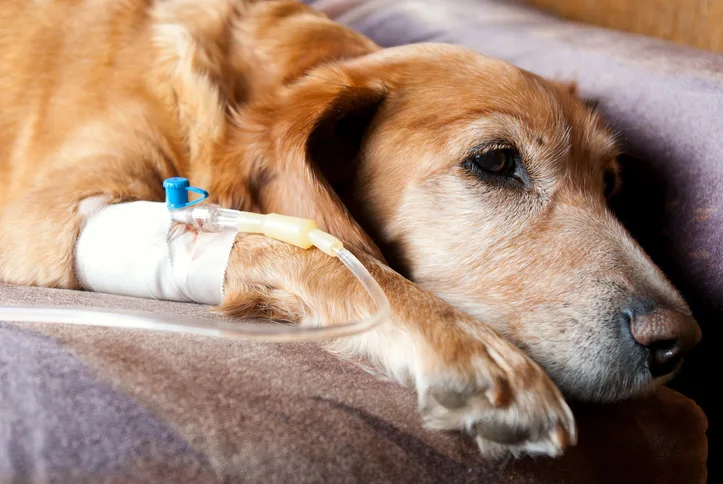
In the Literature
Saba CF, Fan TM, Phillips BS, Wright ZM, Thamm DH. Alternating rabacfosadine and doxorubicin for treatment of naïve canine lymphoma. Vet Comp Oncol. 2024;22(2):278-283. doi:10.1111/vco.12975
The Research …
Multidrug protocols consisting of rotating cyclophosphamide, doxorubicin, vincristine, and prednisone (ie, CHOP) are the standard of care for naive canine multicentric lymphoma and typically result in similar remission rates (overall response rate, 69%-100%) and median progression-free survival (PFS; 4.7-12.5 months).1 Although these protocols have shortened over time, treatment can be weekly for months, which can be difficult for pet owners.2,3 Protocols with less frequent administration but similar efficacy are therefore highly desirable. For example, a protocol comprising alternating doses of rabacfosadine and doxorubicin administered at 3-week intervals was found to have a remission rate of 84% and PFS of 6.5 months.4
This prospective, multi-institutional study further evaluated the rabacfosadine and doxorubicin protocol in 59 dogs with naive multicentric lymphoma. Most dogs (80%) had B-cell lymphoma. Complete staging was not required. Standard doses of rabacfosadine (1 mg/kg IV) were alternated with standard doses of doxorubicin (30 mg/m2 IV for dogs >33 lb [15 kg]; 25 mg/m2 or 1 mg/kg IV for dogs ≤33 lb [15 kg]) every 3 weeks for a planned total of 6 doses (3 doses of each drug).
Overall response rate and PFS were 93% and 6.6 months, respectively. Dogs that achieved complete remission (79%) had significantly longer PFS (7.2 months) compared with those that achieved partial remission (3 months) or did not respond (1.2 months). Dogs with B-cell lymphoma responded significantly longer than those with T-cell lymphoma (6.6 months vs 2 months).
Toxicity was overall as expected for each drug based on existing data; however, prednisone was not initially included in the protocol (n = 34), and 15% of these dogs developed known or presumed pulmonary fibrosis (an adverse effect of rabacfosadine). Prednisone (0.5-1 mg/kg per day) was thus added to the protocol (n = 25), reducing incidence of known or presumed pulmonary fibrosis to 4%, which is consistent with previous reports.4,5 Respiratory signs developed at a median of 120 days from protocol initiation and resulted in euthanasia of 4 dogs.
… The Takeaways
Key pearls to put into practice:
A rabacfosadine and doxorubicin protocol provides outcomes comparable to CHOP and may be preferable for owners concerned with clinic visit frequency; however, rabacfosadine can be significantly more expensive than CHOP, especially for larger dogs that require multiple vials.
In dogs that respond to doxorubicin but not vincristine or cyclophosphamide during a CHOP protocol, conversion to rabacfosadine and doxorubicin may induce and maintain more durable remission than doxorubicin alone, especially dogs with B-cell lymphoma.
In addition to GI and hematologic adverse effects expected with chemotherapy, owners should be made aware of the unique toxicities of doxorubicin and, specifically, rabacfosadine. Rabacfosadine can cause dermatopathy and pulmonary fibrosis, the mechanisms for which are poorly understood. Dermatopathy is common and can usually be managed with dose reductions and delays in administration. Pulmonary fibrosis is relatively rare and idiosyncratic but can be fatal. Concurrent prednisone administration may reduce the risk for pulmonary fibrosis, but benefits are not yet known.
You are reading 2-Minute Takeaways, a research summary resource presented by Clinician’s Brief. Clinician’s Brief does not conduct primary research.